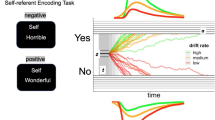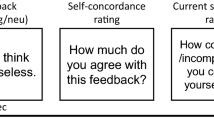Abstract
To competitively test four models of depressive cognition, this study compared the processing strategies used by dysphorics with those used by nondysphorics. Thus, the study was designed to detect which strategies dysphoric and nondysphoric subjects used to process information: (a) data-driven (unbiased), (b) self-derogating (negatively biased), (c) self-enhancing (positively biased), or (d) schematic (self-verifying bias). Subjects took five tests; after receiving contrived feedback, they judged the validity of the tests and later recalled their scores. Evidently, dysphoric and nondysphoric subjects used the same self-enhancing strategy to rate the validity of the tests and the same schematic strategy to recall their scores. The findings support the position that dysphorics use ordinary processing strategies, including the schematic strategy proposed by the self-schema model. However, the findings suggest that dysphorics and nondysphorics alike use different processing strategies in different situations.
Similar content being viewed by others
References
Abramson, L. Y., & Alloy, L. B. (1981). Depression, nondepression, and cognitive illusions: Reply to Schwartz.Journal of Experimental Psychology: General, 100, 436–447.
Abramson, L. Y., & Martin, D. (1981). Depression and the causal inference process. In J. Harvey, W. Ickes, & R. Kidd (Eds.),New directions in attribution research (Vol. 3, pp. 117–168). Hillsdale, NJ: Erlbaum.
Ackermann, R., & DeRubeis, R. J. (1991). Is depressive realism real?Clinical Psychology Review, 11, 565–584.
Alloy, L. B., & Abramson, L. Y. (1979). Judgment of contingency in depressed and nondepressed students: Sadder but wiser?Journal of Experimental Psychology: General, 108, 441–485.
Alloy, L. B., & Abramson, L. Y. (1988). Depressive realism: Four theoretical perspectives. In L. B. Alloy (Ed.),Cognitive processes in depression (pp. 223–265). New York: Guilford Press.
Barber, J. P., & DeRubeis, R. J. (1989). On second thought: Where the action is in cognitive therapy for depression.Cognitive Therapy and Research, 13, 441–457.
Beck, A. T. (1971). Cognition, affect and psychopathology.Archives of General Psychiatry, 24, 495–500.
Beck, A. T. (1987). Cognitive models of depression.Journal of Cognitive Psychotherapy: An International Quarterly, 1, 5–37.
Beck, A. T. (1991). Cognitive therapy: A 30-year retrospective.American Psychologist, 46, 368–375.
Beck, A. T., Rush, A. J., Shaw, B. F., & Emery, G. (1979).Cognitive therapy of depression. New York: Guilford Press.
Brewer, W. F., & Nakamura, G. V. (1984). The nature and functions of schemas. In R. S. Wyer, Jr., & T. K. Srull (Eds.),Handbook of social cognition (pp. 120–160). Hillsdale, NJ: Erlbaum.
Brown, J. D. (1991). Accuracy and bias in self-knowledge. In C. R. Snyder & D. F. Forsyth (Eds.),Handbook of social and clinical psychology: The health perspective (pp. 158–178). New York: Pergamon Press.
Coyne, J. C. (1989). Thinking postcognitively about depression. In A. Freeman, K. M. Simon, L. E. Beutler, & H. Arkowitz (Eds.),Comprehensive handbook of cognitive therapy (pp. 227–244). New York: Plenum Press.
Coyne, J. C., & Gotlib, I. H. (1983). The role of cognition in depression: A critical appraisal.Psychological Bulletin, 94, 472–505.
De La Ronde, C. & Swann, W. B. (1993). Caught in the Crossfire: Positivity and self-verification strivings among people with low self-esteem. In R. F. Baumeister (Ed.),Self-esteem: The puzzle of low self-regard (pp. 147–165). New York: Plenum.
Dobson, K., & Franche, R. (1989). A conceptual and empirical review of the depressive realism hypothesis.Canadian Journal of Behavioral Science, 21, 419–433.
Dykman, B. M., Abramson, L. Y., & Albright, J. (1991). Effects of ascending and descending patterns of success upon dysphoric and nondysphoric subjects' encoding, recall, and predictions of future success.Cognitive Therapy and Research, 15, 179–199.
Dykman, B. M., Abramson, L. Y., Alloy, L. B., & Hartlage, S. (1989). Processing of ambiguous and unambiguous feedback by depressed and nondepressed college students: Schematic biases and their implications for depressive realism.Journal of Personality and Social Psychology, 56, 431–445.
Dykman, B. M., Horowitz, L. M., Abramson, L. Y., & Usher, M. (1991). Schematic and situational determinants of depressed and nondepressed students' interpretation of feedback.Journal of Abnormal Psychology, 100, 45–55.
Engel, R. A., & DeRubeis, R. J. (1993). The role of cognition in depression. In K. S. Dobson & P. C. Kendall (Eds.),Psychopathology and cognition. New York: Academic Press.
Evans, M. D., & Hollon, S. D. (1988). Patterns of personal and causal inference: Implications for the cognitive therapy of depression. In L. B. Alloy (Ed.),Cognitive processes in depression. New York: Guilford Press.
Fiske, S. T., & Taylor, S. E. (1991).Social cognition. New York: McGraw-Hill.
Haaga, D. A. F., Dyck, M. J., & Ernst, D. (1991). Empirical status of cognitive theory of depression.Psychological Bulletin, 110, 215–236.
Hammen, C. L., & Krantz, S. E. (1985). Measures of psychological processes in depression. In E. E. Beckham & W. R. Leber (Eds.),Handbook of depression: Treatment, Assessment and research (pp. 408–444). Homewood, IL: Dorsey Press.
Hollon, S. D., & Garber, J. (1988). Cognitive therapy. In L. Y. Abramson (Ed.),Social cognition and clinical psychology: A synthesis (pp. 204–253). New York: Guilford Press.
Hollon, S. D., & Kriss, M. R. (1984). Cognitive factors in clinical research and practice.Clinical Psychology Review, 4, 35–76.
Ingram, R. E. (1990). Depressive cognition: Models, mechanisms and methods. In. R. E. Ingram (Ed.),Contemporary psychological approaches to depression (pp. 169–195). New York: Plenum Press.
Kendall, P. C. (1992). Healthy thinking.Behavior Therapy, 23, 1–11.
Kendall, P. C., Hollon, S. D., Beck, A. T., Hammen, L. L., & Ingram, R. E. (1987). Issues and recommendations regarding use of the Beck Depression Inventory.Cognitive Therapy and Research, 11, 289–299.
Krantz, S. E. (1985). When depressive cognitions reflect negative realities.Cognitive Therapy and Research, 9, 595–610.
Kruglanski, A. W. (1989). The psychology of being right: the problem of accuracy in social perception and cognition.Psychological Bulletin, 106, 395–409.
Markus, H. (1977). Self-schemas and processing information about the self.Journal of Personality and Social Psychology, 35, 63–78.
Markus, H., & Wurf, E. (1987). The dynamic self-concept: A social psychological perspective:Annual Review of Psychology, 38, 299–337.
Morris, S. J., & Kanfer, F. H. (1995). Self-Evaluation, self-description, and self-standards in subclinical depression.Journal of Psychopathology and Behavioral Assessment, 17, 261–282.
Nisbet, R. E., & Ross, L. (1980).Human inference: Strategies and shortcomings. Englewood Cliffs, NJ: Prentice-Hall.
Pelham, B. W. (1991a). On the benefits of misery: Self-serving biases in the depressive self-concept.Journal of Personality and Social Psychology, 61, 670–681.
Pelham, B. W. (1991b). On confidence and consequence: The certainty and importance of self-knowledge.Journal of Personality and Social Psychology, 60, 518–530.
Pelham, B. W. (1993). On the highly positive thoughts of the highly depressed. In R. F. Baumeister (Ed.),Self-esteem: The puzzle of low self-regard (pp. 183–199). New York: Plenum Press.
Pinkley, R., Laprelle, J., Pyszczynski, T., & Greenberg, J. (1988). Depression and the self-serving search for consensus after success and failure.Journal of Social and Clinical Psychology, 6, 235–244.
Rehm, L. P. (1988). Self-management and cognitive processes in depression. In L. B. Alloy (Ed.),Cognitive processes in depression (pp. 143–176). New York: Guilford Press.
Rude, S. S., Krantz, S. E., & Rosenhan, D. L. (1988). Distinguishing the dimensions of valence and belief consistency in depressive and nondepressive information processing.Cognitive Therapy and Research, 12, 391–407.
Ruehlman, L. S., West, S. G., & Pasahow, R. J. (1985). Depression and evaluative schemata.Journal of Personality, 53, 46–92.
Sackeim, H. A. (1983). Self-deception, self-esteem, and depression: The adaptive value of lying to oneself. In J. Masling (Ed.),Empirical studies of psychoanalytical theories. Hillsdale, NJ: Erlbaum.
Schacter, D. L. (1989). Memory. In M. Posner (Ed.),Foundations of cognitive science. Cambridge, MA: MIT Press.
Sedikides, C. (1993). Assessment, enhancement, and verification determinants of self-evaluation processes.Journal of Personality and Social Psychology, 65, 317–338.
Sedikides, C., & Strube, M. J. (1993).Motivated self-perception: To thine own self be good, to thine own self be true, to thine own self be sure. Unpublished manuscript, University of North Carolina, Chapel Hill.
Segal, Z. U., & Shaw, B. F. (1986). Cognition in depression: A reappraisal of Coyne and Gotlib's critique.Cognitive Therapy and Research, 10, 671–693.
Shrauger, J. S. (1975). Responses to evaluation as a function of initial self-perceptions.Psychological Bulletin, 82, 581–596.
Swann, W. B. (1987). Identity negotiation: Where two roads meet.Journal of Personality and Social Psychology, 53, 1038–1051.
Swann, W. B. (1990). To be known or to be adored: The interplay of self-enhancement and self-verification. In R. M. Sorrentino & E. T. Higgins (Eds.),Handbook of motivation and cognition (Vol. 2). New York: Guilford Press.
Swann, W. B., Wenzlaff, R. M., Krull, D. S., & Pelham, B. W. (1992). Allure of negative feedback: Self-verification strivings among depressed persons.Journal of Abnormal Psychology, 101, 293–306.
Taylor, S. E., & Brown, J. D. (1988). Illusion and well-being: A social psychological perspective on mental health.Psychological Bulletin, 103, 193–210.
Vredenburg, K., Flett, G., & Krames, L. (1993). Analogue versus clinical depression: A critical reappraisal.Psychological Bulletin, 113, 327–344.
Author information
Authors and Affiliations
Additional information
I am grateful to Fred Kanfer, Lenore Harmon, and Ray Bergner, as well as the anonymous reviewers, for their valuable comments on earlier versions of this article. I am also indebted to Lynn Barnett for her assistance in analyzing the data.
Rights and permissions
About this article
Cite this article
Morris, S.J. Processing strategies used by dysphoric individuals: Self-derogating, non-self-enhancing, or schematic?. Cogn Ther Res 20, 213–233 (1996). https://doi.org/10.1007/BF02229234
Issue Date:
DOI: https://doi.org/10.1007/BF02229234




